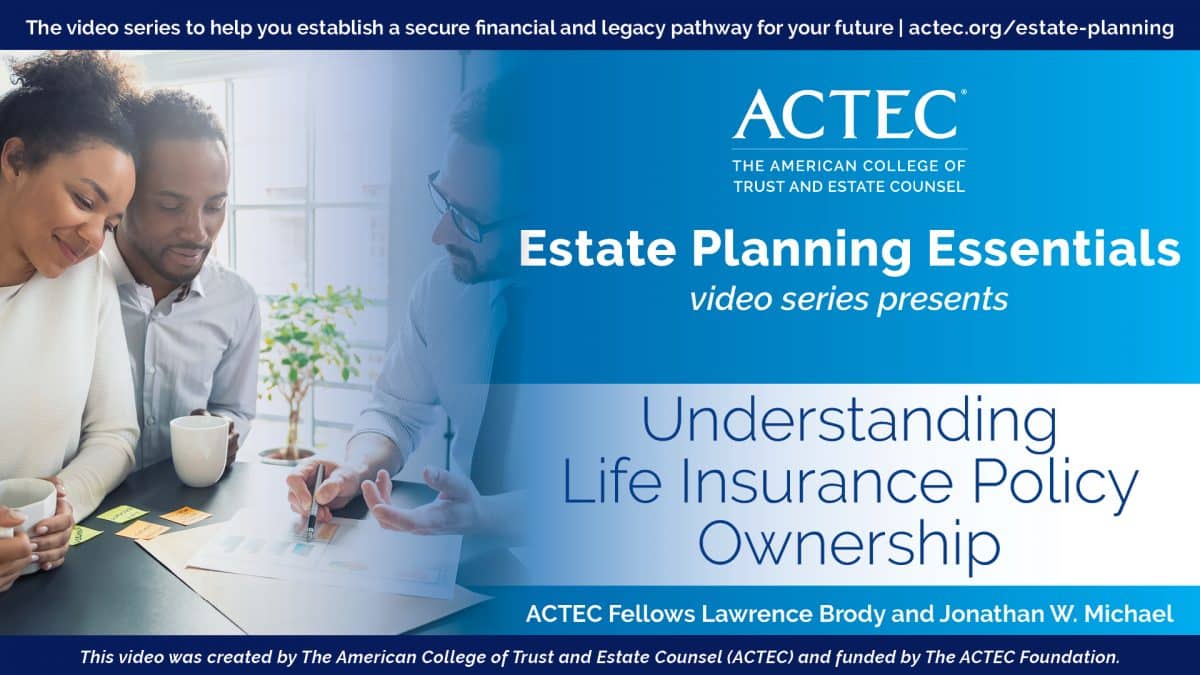There are several types of life insurance policies on the market with varying degrees of risk. What are the advantages and disadvantages of each type? How do you decide which is the right fit?
ACTEC Fellows Lawrence Brody and Jonathan W. Michael give a general overview of the opportunities and risks associated with term and permanent life insurance policies and how those factors are related to premiums.
Transcript
Hello, my name is Jonathan W. Michael, an ACTEC Fellow in Chicago, and I am here today with Larry Brody an ACTEC Fellow in St. Louis.
Hello Jonathan, how are you?
I’m doing great. So, Larry is our guest and today he’s going to tell us about choices of life insurance policies. And with that in mind Larry, maybe you could tell us a little bit about different types of life insurance policies.
Jonathan, there are essentially two different types of life insurance policies– one are term policies, the other are what are called permanent policies. Term policies are pure death benefit policies, they have no cash value, no investment element. They just provide a death benefit in exchange for premiums for some period of time. Some term policies are one year term policies that you have to re-up for every year and every year there’s a higher premium because you are 1 year older. There are other term policies that are called level term policies where you can buy a term policy, for instance, for 10 years, 20 years, or maybe 30 years, that has a fixed policy premium for that period of time; it doesn’t go up. But, what you’re doing effectively there is prepaying in the early years, so you can underpay in the later years. Both kinds of term policies have what are called convertibility features which allow you, without evidence of insurability, to convert to a permanent policy, again, without taking another physical. Very helpful for someone who has a term policy, wants to renew it and can’t qualify because they are now less healthy. That convertibility feature is very important in term policies
How about, Larry, what are some of the choices available for each type of insurance, meaning term and permanent?
Well again, for term, the choices are either annually renewable term or level term. For permanent policies there are some permanent policies which have fixed premiums and guaranteed increases in cash surrender value. Those kinds of policies have very low investment risk because the insurance company guarantees both the death benefit, if you pay the premium every year, and the increase in the cash surrender value. Those are sometimes called traditional whole-life policies, and they were the first permanent policies ever developed. Later kinds of permanent policies allow both the carrier, the insurance company, and the policy owner to share in the investment risk so there’s not the same kind of guarantee by the insurance company of increases in cash value. They will guarantee that if you pay the premium you will get, or your beneficiaries will get, the death benefit but they may, for instance, provide that instead of getting a guaranteed interest rate every year, your policy cash values will be credited with interest based on what’s going on in the market with some minimum floor. So, in effect, the insurance company and the policy owner are sharing the interest rate investment risk.
There are other kinds of newer permanent policies which allow the policyowner to invest his or her cash value in the equity markets, and there the insurance company provides no guarantees of investment return. The policy earns whatever it earns in the investment market, in the equity market, and the policy owner gets to choose among a number of mutual funds offered under the policy, all in the equity market.
I presume the same would be with respect to the choices that clients make with respect to insurance policies. Will you let us know a little bit about who might be interested in one type of policy versus another? We all understand that it’s going to be a specific decision at the end of the day.
Exactly. Sure. And again, it is a choice made by the prospective policy owner in association with his or her insurance agent. So, you will get input from your insurance agent on what kind of policy they think you might be best suited for. But, I suppose you can generalize that in general younger healthier insureds are more likely to gravitate toward term insurance, because the term costs are much lower than permanent policy premiums because there is no savings element. You’re just buying death benefit, you’re not buying a combination of death benefit and cash value. So, for younger insureds who might have lower income, returns and lower (smaller) assets, term insurance probably makes the most sense. You get the most death benefit for the least premium. And so, if you’ve got a young couple with children and they’re worried about what happens to the children if something happens to one or both parents a large term policy, relatively inexpensively, could provide that protection.
Permanent insurance is generally purchased by older insureds who have a permanent need. A young couple might want to buy term insurance until, for instance, their children are grown. An older couple might want to buy insurance on one spouse, for the benefit of the other spouse. If one spouse is the working spouse, and that working spouse dies early, the other spouse needs a death benefit from that policy to continue their livelihood. So, in general, again, you’re right, it’s a client specific issue. But in general, younger insureds gravitate towards term policies and older, more wealthy insureds gravitate to permanent policies because, again, they will last throughout life if you pay the premium and there is a savings element which you can access either by borrowing from the policy or withdrawing money from the policy, generally, on an income tax free basis.
So, there is no savings element with respect to the term policy. Let me get to my last question, which would be: what are some of the investment risks, if any, associated with a permanent policy?
There is again, there are some permanent policies, traditional whole life is an example, where the insurance company guarantees the death benefit if you paid a premium and guarantees that the cash value will increase at stated rates. There, there is no investment risk for the policy owner; as long as the insurance company stays in business, a death benefit will be paid at death and cash value will increase as shown in the policy.
For the newer kinds of policies where there’s a sharing of investment risk between the insurance company and the owner, or newer policies again, where cash values can be invested in the equity markets, there is some sharing of risk in the first kind of policy and, in the second kind of policy (the equity policies) the insurance company guarantees nothing about return and so all of the risk is on the policy owner. So, which kind of permanent policy a client might think about depends in part on their willingness to take investment risk in their policy. Some clients view their insurance policies, permanent policies, as a part of a risk-free portfolio. Some clients are comfortable having their cash value invested in the equity market. And, some clients come out somewhere in between. It really depends on the risk tolerance of the policy owner. Again, it’s an issue in dealing with your agent to be sure that your agent is matching your risk tolerance with the policy he, or she is showing you.
Alright, well thank you Larry for explaining to us different choices of life insurance policies.
Featured Video
Understanding Life Insurance Policy Ownership
Answers to your life insurance policy regarding ownership, insurance options, an explanation of irrevocable life insurance trust and more from an estate expert.
ACTEC Estate Planning Essentials

ACTEC Fellows provide answers to frequently asked trust and estate planning questions in this video series.



